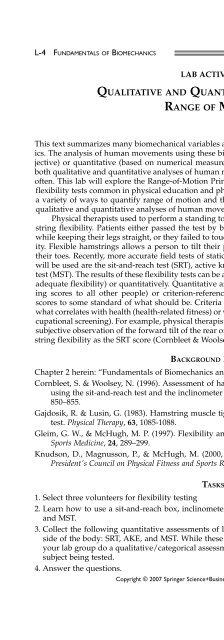Fundamentals of Biomechanics
Fundamentals of Biomechanics
Fundamentals of Biomechanics
Create successful ePaper yourself
Turn your PDF publications into a flip-book with our unique Google optimized e-Paper software.
L-4 FUNDAMENTALS OF BIOMECHANICS<br />
LAB ACTIVITY 2<br />
QUALITATIVE AND QUANTITATIVE ANALYSIS OF<br />
RANGE OF MOTION<br />
This text summarizes many biomechanical variables and concepts into nine principles <strong>of</strong> biomechanics.<br />
The analysis <strong>of</strong> human movements using these biomechanical principles can be qualitative (subjective)<br />
or quantitative (based on numerical measurements). All kinesiology pr<strong>of</strong>essions have used<br />
both qualitative and quantitative analyses <strong>of</strong> human movement, but qualitative analysis is used most<br />
<strong>of</strong>ten. This lab will explore the Range-<strong>of</strong>-Motion Principle <strong>of</strong> biomechanics, using a variety <strong>of</strong> static<br />
flexibility tests common in physical education and physical therapy. This lab will show you there are<br />
a variety <strong>of</strong> ways to quantify range <strong>of</strong> motion and that there are strengths and weaknesses <strong>of</strong> both<br />
qualitative and quantitative analyses <strong>of</strong> human movement.<br />
Physical therapists used to perform a standing toe touch to screen for persons with limited hamstring<br />
flexibility. Patients either passed the test by being able to touch their toes with their fingers<br />
while keeping their legs straight, or they failed to touch their toes, indicating poor hamstring flexibility.<br />
Flexible hamstrings allows a person to tilt their pelvis forward more, making it easier to touch<br />
their toes. Recently, more accurate field tests <strong>of</strong> static flexibility have been developed. The tests that<br />
will be used are the sit-and-reach test (SRT), active knee extension (AKE), and the modified Schober<br />
test (MST). The results <strong>of</strong> these flexibility tests can be analyzed qualitatively (judging if the subject has<br />
adequate flexibility) or quantitatively. Quantitative analysis can either be norm-referenced (comparing<br />
scores to all other people) or criterion-referenced. Criterion-referenced testing compares test<br />
scores to some standard <strong>of</strong> what should be. Criteria or standards are usually based on evidence on<br />
what correlates with health (health-related fitness) or with physical abilities to perform jobs safely (occupational<br />
screening). For example, physical therapists studying the sit-and-reach test suggested that<br />
subjective observation <strong>of</strong> the forward tilt <strong>of</strong> the rear <strong>of</strong> the pelvis is as effective an assessment <strong>of</strong> hamstring<br />
flexibility as the SRT score (Cornbleet & Woolsey, 1996).<br />
BACKGROUND READING<br />
Chapter 2 herein: “<strong>Fundamentals</strong> <strong>of</strong> <strong>Biomechanics</strong> and Qualitative Analysis”<br />
Cornbleet, S. & Woolsey, N. (1996). Assessment <strong>of</strong> hamstring muscle length in school-aged children<br />
using the sit-and-reach test and the inclinometer measure <strong>of</strong> hip joint angle. Physical Therapy, 76,<br />
850–855.<br />
Gajdosik, R. & Lusin, G. (1983). Hamstring muscle tightness: Reliability <strong>of</strong> an active–knee-extension<br />
test. Physical Therapy, 63, 1085-1088.<br />
Gleim, G. W., & McHugh, M. P. (1997). Flexibility and its effects on sports injury and performance.<br />
Sports Medicine, 24, 289–299.<br />
Knudson, D., Magnusson, P., & McHugh, M. (2000, June). Current issues in flexibility fitness. The<br />
President's Council on Physical Fitness and Sports Research Digest, pp. 1-8.<br />
TASKS<br />
1. Select three volunteers for flexibility testing<br />
2. Learn how to use a sit-and-reach box, inclinometer, goniometer, and tape measure for SRT, AKE,<br />
and MST.<br />
3. Collect the following quantitative assessments <strong>of</strong> lumbar and hamstring range <strong>of</strong> motion for one<br />
side <strong>of</strong> the body: SRT, AKE, and MST. While these measurements are being taken, have people in<br />
your lab group do a qualitative/categorical assessment (hyp<strong>of</strong>lexible, normal, hyperflexible) <strong>of</strong> the<br />
subject being tested.<br />
4. Answer the questions.<br />
Copyright © 2007 Springer Science+Business Media, LLC.All rights reserved.






